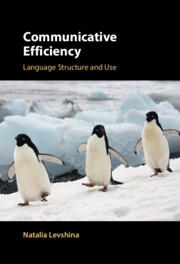Book contents
- Communicative Efficiency
- Communicative Efficiency
- Copyright page
- Dedication
- Contents
- Figures
- Tables
- Preface
- Acknowledgements
- Abbreviations
- Part I Different Types of Efficiency in Language
- Part II Efficiency and Language Evolution
- Part III Case Studies
- 7 Efficient Form–Meaning Mapping in Causative Constructions
- 8 Differential Case Marking and Efficiency
- 9 Efficient Use of Function Words in English Alternations
- 10 Conclusions and Perspectives
- Appendices
- References
- Index
9 - Efficient Use of Function Words in English Alternations
from Part III - Case Studies
Published online by Cambridge University Press: 03 November 2022
- Communicative Efficiency
- Communicative Efficiency
- Copyright page
- Dedication
- Contents
- Figures
- Tables
- Preface
- Acknowledgements
- Abbreviations
- Part I Different Types of Efficiency in Language
- Part II Efficiency and Language Evolution
- Part III Case Studies
- 7 Efficient Form–Meaning Mapping in Causative Constructions
- 8 Differential Case Marking and Efficiency
- 9 Efficient Use of Function Words in English Alternations
- 10 Conclusions and Perspectives
- Appendices
- References
- Index
Summary
This chapter presents three case studies that demonstrate that accessibility based on predictability relationships between constructions and their lexical fillers plays a role in alternations with longer and shorter alternative forms. The alternations are help + (to) Infinitive, Verb (at) home and go (and) Verb. I formulate the Hypothesis of Construction–Lexeme and Formal Length, which predicts the longer variants to be used when the associations are weaker, and shorter forms when the associations are stronger. This study demonstrates that the probabilistic relationships between constructions and collexemes can explain the choice between the shorter and longer constructional variants, which needs to be integrated in Constructionist theory. Moreover, we also see many other manifestations of high and low accessibility that determine the use of longer and shorter variants. This shows that language users adjust their output to the individual situation in many very subtle ways, depending on semantic features, inflectional forms, distances between constructional components, and many other factors.
Information
- Type
- Chapter
- Information
- Communicative EfficiencyLanguage Structure and Use, pp. 230 - 244Publisher: Cambridge University PressPrint publication year: 2022
